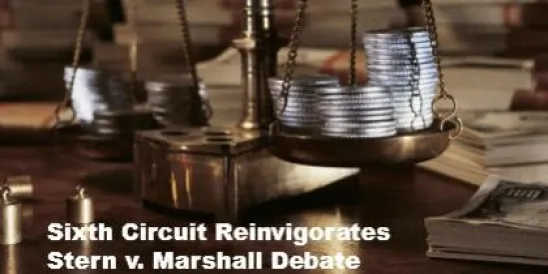In a surprising decision certain to reinvigorate the ongoing debate about the scope of Stern v. Marshall, ___ U.S. ___, 131 S. Ct. 2594 (2011), the Sixth Circuit Court of Appeals adopted a broad view of Stern and held that the structural nature of the limitations imposed on bankruptcy courts by Article III of the Constitution could not be waived by a party’s failure to object at the trial court level. The decision, Waldman v. Stone, 2012 WL 5275241 (6th Cir. Oct. 26, 2012), brings renewed uncertainty to the oft-litigated questions regarding the constitutional limits of a bankruptcy court to adjudicate both core and non-core claims.
Many lower court opinions and recent rule changes intended to address the problem caused by the Stern decision are based on the assumption that an objection to the authority of the bankruptcy court can be waived by the parties. In addition to its rejection of this waiver principle as a basis for bankruptcy courts to issue final judgments in certain proceedings before them, the Sixth Circuit suggests that a “statutory gap” in 28 U.S.C. section 157 may prevent a bankruptcy court from issuing proposed findings of fact and conclusions of law in core matters. If adopted by other courts outside the Sixth Circuit, the decision in Waldman is likely to foster increased delay and expense in litigation originating in the bankruptcy courts.
The Waldman case arose in the context of an individual chapter 11 bankruptcy case wherein the debtor (Stone) commenced an adversary proceeding alleging he had been defrauded by his largest creditor (Waldman), and seeking both disallowance of Waldman’s claims (disallowance claims) and an affirmative award of money damages (affirmative claims). After trial, the bankruptcy court entered a final judgment in favor of Stone on both the disallowance claims and the affirmative claims, disallowing Waldman’s claims in their entirety and awarding compensatory and punitive damages of $3 million. The district court affirmed the bankruptcy court’s judgment in all respects.
On appeal to the Sixth Circuit, Waldman argued for the first time that the bankruptcy court lacked constitutional authority under Article III to enter judgment on both Stone’s disallowance and affirmative claims. The threshold issue was whether Waldman’s failure to challenge the bankruptcy court’s constitutional authority below effected a waiver of his right to raise the constitutional challenge on appeal. Answering in the negative, the Sixth Circuit rejected the argument that in the bankruptcy context the right to adjudication by an Article III judge is only a personal right of litigants that, in this case, was waived by Waldman’s failure to object below. Noting that the personal right of the litigant is only one aspect of the “dual character” of Article III, id at 4, the court found that in the bankruptcy context the structural principles advanced by Article III safeguard against the diminution of the authority of the judiciary. This structural principle, the court held, “is not Waldman’s to waive.” Id. at 5.
Addressing the merits of the objection, the Sixth Circuit turned to the “public rights” exception to the rule that the adjudication of private rights is reserved to an Article III judge. Following Stern and its predecessors, the court described a “public rights” claim as “one that derives from a federal regulatory scheme, or in which resolution of the claim by an expert governmental agency is essential to a limited regulatory objective within the agency’s authority.” Id. at 5 (internal quotation omitted). Describing the application of this test in the bankruptcy arena as having a “potluck quality,” id., the Sixth Circuit concluded that under the “public rights” exception after Stern, a bankruptcy court’s authority is at its constitutional maximum when a debtor pleads an action under federal bankruptcy law and seeks disallowance of a creditor’s proof of claim against the estate. At the other extreme, the court held that a bankruptcy court lacks constitutional authority when the debtor brings an action arising only under state law, or one that would augment the bankruptcy estate but not necessarily be resolved in the claims administration process.
Applying the “public rights” exception on these terms, the Sixth Circuit addressed separately Stone’s disallowance claims and his affirmative claims. Consistent with its structural approach, the court quickly concluded that the disallowance claims fell within the bankruptcy court’s constitutional authority notwithstanding that Waldman had not filed a proof of claim, rejecting the argument that under pre-Stern precedent the claims allowance process must be triggered by the filing of a proof of claim or other act of consent. The court reasoned that although the bases for disallowance arose solely under state law, the bankruptcy court had constitutional authority over the disallowance claims because the claims allowance process itself arises under federal law (i.e., 11 U.S.C. § 502(b)) and has been the purview of bankruptcy courts “for more than two centuries.” Id. at 8.
(It is worthy of a digression here to note that notwithstanding its roots in historical and structural reasoning, the Sixth Circuit’s decision on this issue should be recognized as an extension of the law. Under its structural approach, a creditor is drawn into the claims allowance process solely by virtue of its creditor status without regard to whether it elects to participate in the distribution from the estate’s assets by filing a proof of claim. Among other implications, this extension of the law would appear to allow trustees (or debtors in possession) to use their authority under 11 U.S.C. § 501 to file proofs of claims on behalf of a creditor and obtain a final judgment to reduce or eliminate the creditor’s claim.)
Having affirmed the disallowance claims, the Sixth Circuit nevertheless concluded that Stone’s affirmative claims were not within the bankruptcy court’s constitutional authority. Those claims arose exclusively under state law, did not invoke the claims allowance process, and sought only to augment the bankruptcy estate through an award of money damages. The Sixth Circuit rejected Stone’s argument that the same fraudulent conduct by Waldman gave rise to both of his claims against Waldman, noting that under Stern the test for whether claims seeking affirmative relief fall within the claims allowance process is not “some overlap” but whether the claims allowance process “would necessarily resolve” the affirmative claims. Id. (quoting Stern, 131 S. Ct. at 2617). As the affirmative claims failed to meet this “necessarily resolve” test because they required him to prove facts beyond those necessary to his disallowance claims, the Sixth Circuit concluded that that bankruptcy court lacked constitutional authority to enter judgment on the affirmative claims.
The court’s conclusion raised the issue of what remedy on appeal is appropriate where a bankruptcy court enters final judgment on a claim over which it lacks constitutional authority. While acknowledging that the “practical remedy” would be to instruct the bankruptcy court to convert its final judgment into proposed findings of fact and conclusions of law and submit them to the district court for de novo review under 28 U.S.C. § 157(c)(1), the Sixth Circuit found that a “statutory gap” exists such that the bankruptcy court does not have express statutory authority to issue proposed findings and conclusions as to core claims. Although positing that the statutory authority to enter final judgments implies the lesser authority to propose findings and conclusions, the Sixth Circuit did not resolve this issue.
Rather, the court sidestepped the “statutory gap” issue by ruling, without regard to Waldman’s waiver, that the affirmative claims were non-core because they arose solely under state law and did not fall within the categories of proceedings defined as core in 28 U.S.C. § 157(b)(2). The court further concluded that Waldman’s waiver was of no moment in that any waiver of his statutory rights did not limit the court from correctly classifying Stone’s affirmative claims as non-core and thus within the statutory authority of the bankruptcy court to issue proposed findings and conclusions under 28 U.S.C. § 157(c).
On the basis that the bankruptcy court had clear statutory authority to issue proposed findings and conclusions as to non-core claims, the Sixth Circuit vacated the bankruptcy court’s judgment on the affirmative claims and remanded to the bankruptcy court with instructions to “recast” its judgment as proposed findings of fact and conclusions of law for submission to the district court in accordance with 28 U.S.C. § 157(c) and Federal Rule of Bankruptcy Procedure 9033. Id. at 9.
The Waldman decision is significant because it rejects or casts doubt on the efforts of bankruptcy and district courts around the country to address the uncertainty created by Stern. Many of these efforts rely upon a party’s failure to object initially to a bankruptcy court’s constitutional authority, and a consequent finding or deeming of a waiver. Waldman rejects any notion of waiver and effectively enables a party to object to a bankruptcy court’s constitutional authority at any time, even for the first time on appeal.
Another common device relied upon by bankruptcy and district courts is to provide that a district court may simply treat as proposed findings and conclusions a final judgment entered by a bankruptcy court on a claim over which it lacks constitutional authority. In its discussion of the “statutory gap,” the Sixth Circuit casts doubt whether statutory authority even exists to issue proposed findings and conclusions as to core claims. Even where a bankruptcy court may make proposed findings and conclusions, Waldman shows that the remedy on appellate review is not simply to treat the bankruptcy court’s judgment as proposed findings and conclusion, but rather to vacate and remand with instructions for the bankruptcy court to recast and resubmit.
The overall result of Waldman and decisions of other courts that may choose to follow it is likely to be an increase in delay and litigation expense. Parties may be forced to make multiple appearances before the bankruptcy and district courts to fix the extent of a bankruptcy court’s constitutional authority on a claim-by-claim basis, and the specter of a constitutional challenge on appeal will loom large over any case in which the issue exists.
Parties may also be forced to engage in more extensive merits litigation before the district court. The losing side may seek to use the command of de novo review in 28 U.S.C. § 157(c) and the opportunity to request the district court to hear “further evidence” in Federal Rule of Bankruptcy Procedure 9033 to take a “second bite at the apple.” In some cases, additional or repeat testimony may be required. For example in Waldman, as the Sixth Circuit noted, the “most important evidence at trial” was the testimony of Stone and Waldman. Id. at 10. Query whether the district court may resolve Stone’s claims for affirmative relief consistent with the commands of Article III without hearing live testimony from both witnesses. In this case and similar cases, the full logic of Stern and Waldman may require a “second bite,” with all the attendant increases in delay and expense.
In short, the game of “jurisdictional ping-pong” about which Justice Breyer warned in his dissenting opinion in Stern may now become a reality within the Sixth Circuit and in bankruptcy courts across the country. 131 S.Ct. at 2630.




 />i
/>i
